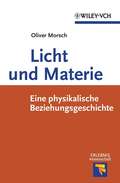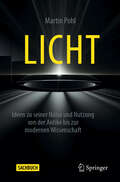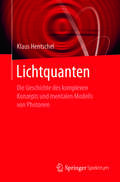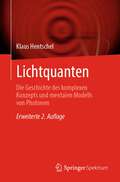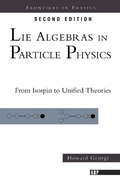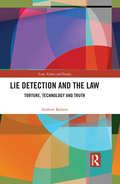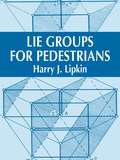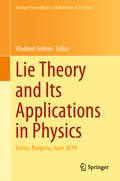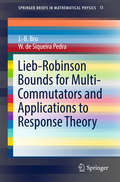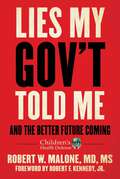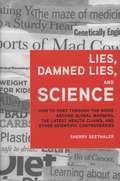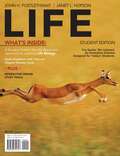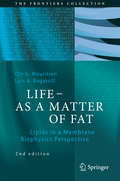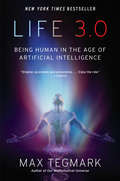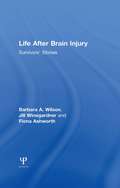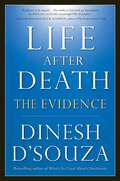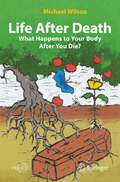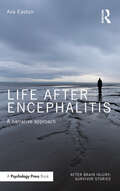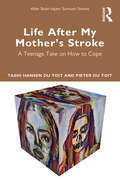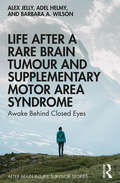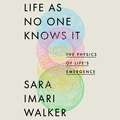- Table View
- List View
Licht und Materie: Eine Physikalische Beziehungsgeschichte (Erlebnis Wissenschaft)
by Oliver MorschDies ist eine Beziehungsgeschichte, deren Hauptpersonen beim Sonnenbaden eine äußerst wichtige Rolle spielen: das Licht und die Materie. Dass Sonnenlicht unsere Haut wärmen und bräunen kann, wissen wir. Doch Licht und Materie können noch ganz andere Dinge: Wer hätte gedacht, dass Licht nicht nur wärmen, sondern auch kühlen kann? Oder dass man mit gebündeltem Licht nicht nur Löcher ins Papier brennen, sondern auch ganz winzig kleine, einzelne Atome festhalten kann? Und was haben Lichtteilchen mit Geheimcodes zu tun? Oliver Morsch, Physiker und Wissenschaftsjournalist, zeigt Ihnen in diesem kurzweiligen und sehr verständlich geschriebenen Buch, dass viele heutige Errungenschaften und zukünftige Technologien auf den Erkenntnissen der Atomphysik beruhen. Viel Spaß beim Lesen!
Licht: Ideen zu seiner Natur und Nutzung von der Antike bis zur modernen Wissenschaft
by Martin PohlUnsere wohl am weitesten entwickelten Sinnesorgane sind die Augen. Direkt mit dem Gehirn verbunden, speisen die hundert Millionen Lichtrezeptoren unserer Netzhaut geschätzte zehn Megabits pro Sekunde in unser Gehirn ein. So erlaubt uns das visuelle System seit frühester Kindheit, unsere Umwelt zu erfassen und zu interpretieren. Bereits die antiken Naturphilosophen haben sich mit Licht und dem Sehvorgang beschäftigt. Die Entwicklung der Wissenschaft, wie wir sie heute kennen, lässt sich anhand des Leitmotivs Licht gut nachzeichnen. Licht und verwandte Boten geben Auskunft über so faszinierende Phänomene wie die Babyjahre des Universums, Vergangenheit und Gegenwart entfernter Himmelskörper und die Beschaffenheit der mikroskopischen Welt. Sie sind ein Werkzeug in Kosmologie, Astronomie, Teilchenphysik und Medizin. Das Buch analysiert Ideen über Licht – seine Natur, Entstehung und Wirkung – von der griechischen Antike bis heute. Die Wechselwirkung zwischen Theorien, Methodologie, Instrumenten und mathematischen Werkzeugen der jeweiligen Zeit wird beleuchtet. Feuilletonistische Schlaglichter auf Kunst und Kultur machen den Zeitgeist lebendig, vor dessen Hintergrund diese Entwicklungen stattgefunden haben.
Lichtquanten: Die Geschichte des komplexen Konzepts und mentalen Modells von Photonen
by Klaus HentschelDieses Buch besch#65533;ftigt sich mit der Entstehungsgeschichte des komplexen Konzeptes des Photons aus wissenschaftshistorischer, kognitionspsychologischer und naturwissenschaftlicher Sicht. Dabei werden unter anderem sechs verschiedene mentale Modelle des Lichtquantums bzw. Photons diskutiert und der Bogen vom Teilchenmodell Newtons, dem Singularit#65533;tsmodell Einstein und Bohrs bis zum modernen Konzept der Quantisierung des elektromagnetischen Feldes in der Quantenelektrodynamik gespannt. Der Autor besch#65533;ftigt sich zuerst mit der Entwicklungsgeschichte des Photons innerhalb der modernen Physik ab 1900, bevor er die zw#65533;lf semantischen Bedeutungsschichten des Photons ausgehend vom Anfang des 20. Jahrhunderts pr#65533;sentiert. Anschlie#65533;end werden die mentalen Modelle im Laufe der Geschichte bis zur Moderne beschrieben und diskutiert und das heutige Modell des Photons besprochen. Das Buch richtet sich sowohl an Naturwissenschaftler mit physikalischem Hintergrund als auch an Wissenscha ftshistoriker und Andere, die sich mit der Begriffs- und Ideengeschichte von Konzepten auseinandersetzen.
Lichtquanten: Die Geschichte des komplexen Konzepts und mentalen Modells von Photonen
by Klaus HentschelDieses Buch beschäftigt sich mit der Entstehungsgeschichte des komplexen Konzeptes von Photonen aus wissenschaftshistorischer, kognitionspsychologischer und naturwissenschaftlicher Sicht. Dabei werden unter anderem sechs verschiedene mentale Modelle des Lichtquantums bzw. Photons diskutiert. Der Bogen wird vom Teilchenmodell Newtons, dem Singularitätsmodell Einsteins und Bohrs bis zum modernen Konzept der Quantisierung des elektromagnetischen Feldes in der Quantenelektrodynamik gespannt. Der Autor beschäftigt sich zuerst mit der Entwicklungsgeschichte des Photons innerhalb der modernen Physik ab 1900, bevor er zwölf Bedeutungsschichten des Photons ausgehend vom Anfang des 20. Jahrhunderts präsentiert. Anschließend werden die mentalen Modelle des quantisierten Lichts diskutiert und das heutige Modell des Photons besprochen.Die deutlich erweiterte zweite Auflage des Buches wurde unter anderem durch zusätzliche Abschnitte über semiklassische Theorien, Dirac, QED und über die Feynman Lectures ergänzt. Ferner wurde das Kapitel über verschiedene Modelle der Begriffsentwicklung und den hier vertretenen Ansatz der Suche nach mentalen Modellen stark erweitert. Das Buch richtet sich sowohl an Naturwissenschaftler wie auch an Wissenschaftshistoriker und Andere, die sich mit der Begriffs- und Ideengeschichte von Konzepten auseinandersetzen.
Lie Algebras In Particle Physics
by Howard GeorgiGeorgi's Harvard lectures (he's taught physics there since 1980) discuss application of the theory of Lie Algebras and their representations to a wide variety of problems in particles physics and quantum mechanics. This edition has been expanded to include more extensive discussion of finite group theory and representations of the permutation group, as well as discussion of new subjects such as Dynkin indices, spontaneous symmetry breaking, lepton number as a fourth color, and the 27-dimensional representation of E(6). Annotation c. Book News, Inc. , Portland, OR (booknews. com)
Lie Algebras In Particle Physics
by Howard GeorgiHoward Georgi is the co-inventor (with Sheldon Glashow) of the SU(5) theory. This extensively revised and updated edition of his classic text makes the theory of Lie groups accessible to graduate students, while offering a perspective on the way in which knowledge of such groups can provide an insight into the development of unified theories of strong, weak, and electromagnetic interactions.
Lie Algebras In Particle Physics
by Howard GeorgiHoward Georgi is the co-inventor (with Sheldon Glashow) of the SU(5) theory. This extensively revised and updated edition of his classic text makes the theory of Lie groups accessible to graduate students, while offering a perspective on the way in which knowledge of such groups can provide an insight into the development of unified theories of strong, weak, and electromagnetic interactions.
Lie Algebras In Particle Physics
by Howard GeorgiHoward Georgi is the co-inventor (with Sheldon Glashow) of the SU(5) theory. This extensively revised and updated edition of his classic text makes the theory of Lie groups accessible to graduate students, while offering a perspective on the way in which knowledge of such groups can provide an insight into the development of unified theories of strong, weak, and electromagnetic interactions.
Lie Detection and the Law: Torture, Technology and Truth (Law, Science and Society)
by Andrew BalmerThis book develops a sociological account of lie detection practices and uses this to think about lying more generally. Bringing together insights from sociology, social history, socio-legal studies and science and technology studies (STS), it explores how torture and technology have been used to try to discern the truth. It examines a variety of socio-legal practices, including trial by ordeal in Europe, the American criminal jury trial, police interrogations using the polygraph machine, and the post-conviction management of sex offenders in the USA and the UK. Moving across these different contexts, it articulates how uncertainties in the use of lie detection technologies are managed, and the complex roles they play in legal spaces. Alongside this story, the book surveys some of the different ways in which lying is understood in philosophy, law and social order. Lie Detection and the Law will be of interest to STS researchers, socio-legal scholars, criminologists and sociologists, as well as others working at the intersections of law and science.
Lie Groups for Pedestrians
by Harry J. LipkinAccording to the author of this concise, high-level study, physicists often shy away from group theory, perhaps because they are unsure which parts of the subject belong to the physicist and which belong to the mathematician. However, it is possible for physicists to understand and use many techniques which have a group theoretical basis without necessarily understanding all of group theory. This book is designed to familiarize physicists with those techniques. Specifically, the author aims to show how the well-known methods of angular momentum algebra can be extended to treat other Lie groups, with examples illustrating the application of the method.Chapters cover such topics as a simple example of isospin; the group SU3 and its application to elementary particles; the three-dimensional harmonic oscillator; algebras of operators which change the number of particles; permutations; bookkeeping and Young diagrams; and the groups SU4, SU6, and SU12, an introduction to groups of higher rank. Four appendices provide additional valuable data.
Lie Theory and Its Applications in Physics: Varna, Bulgaria, June 2019 (Springer Proceedings in Mathematics & Statistics #335)
by Vladimir DobrevThis volume presents modern trends in the area of symmetries and their applications based on contributions to the workshop "Lie Theory and Its Applications in Physics" held near Varna (Bulgaria) in June 2019. Traditionally, Lie theory is a tool to build mathematical models for physical systems. Recently, the trend is towards geometrization of the mathematical description of physical systems and objects. A geometric approach to a system yields in general some notion of symmetry, which is very helpful in understanding its structure. Geometrization and symmetries are meant in their widest sense, i.e., representation theory, algebraic geometry, number theory, infinite-dimensional Lie algebras and groups, superalgebras and supergroups, groups and quantum groups, noncommutative geometry, symmetries of linear and nonlinear partial differential operators, special functions, and others. Furthermore, the necessary tools from functional analysis are included. This is a large interdisciplinary and interrelated field. The topics covered in this volume from the workshop represent the most modern trends in the field : Representation Theory, Symmetries in String Theories, Symmetries in Gravity Theories, Supergravity, Conformal Field Theory, Integrable Systems, Polylogarithms, and Supersymmetry. They also include Supersymmetric Calogero-type models, Quantum Groups, Deformations, Quantum Computing and Deep Learning, Entanglement, Applications to Quantum Theory, and Exceptional Quantum Algebra for the standard model of particle physics This book is suitable for a broad audience of mathematicians, mathematical physicists, and theoretical physicists, including researchers and graduate students interested in Lie Theory.
Lieb-Robinson Bounds for Multi-Commutators and Applications to Response Theory
by J. B. Bru W. de Siqueira PedraLieb-Robinson bounds for multi-commutators are effective mathematical tools to handle analytic aspects of infinite volume dynamics of non-relativistic quantum particles with short-range, possibly time-dependent interactions. In particular, the existence of fundamental solutions is shown for those (non-autonomous) C*-dynamical systems for which the usual conditions found in standard theories of (parabolic or hyperbolic) non-autonomous evolution equations are not given. In mathematical physics, bounds on multi-commutators of an order higher than two can be used to study linear and non-linear responses of interacting particles to external perturbations. These bounds are derived for lattice fermions, in view of applications to microscopic quantum theory of electrical conduction discussed in this book. All results also apply to quantum spin systems, with obvious modifications. In order to make the results accessible to a wide audience, in particular to students in mathematics with little Physics background, basics of Quantum Mechanics are presented, keeping in mind its algebraic formulation. The C*-algebraic setting for lattice fermions, as well as the celebrated Lieb-Robinson bounds for commutators, are explained in detail, for completeness.
Lies My Gov't Told Me: And the Better Future Coming (Children’s Health Defense)
by Robert W. Malone**AS SEEN ON TUCKER CARLSON TODAY AND THE JOE ROGAN EXPERIENCE**A guide for the times—breaking down the lies about COVID-19 and shedding light on why we came to believe them. When he invented the original mRNA vaccine technology as a medical and graduate student in the late 1980s, Robert Malone could not have imagined that he would become a leader in a movement to expose the dangers of mRNA vaccines that billions of people have received—too often without being informed of the risks. For voicing opposition to the &“mainstream&” narrative, Dr. Robert Malone was censored by Big Tech and vilified by the media. But he continues to speak out and alert the world to the web of lies that we have all experienced. From vaccine safety and effectiveness to early treatments like ivermectin, to lockdowns, masks, and more, Dr. Malone is the signature dissident voice telling the other side of the story about COVID, the role of corporate media, censorship, propaganda, and the brave new world of transhumanism promoted by the World Economic Forum and its acolytes. What effect did the COVID policies have on lives, livelihoods, and democracies? How is it possible that the lies spread by governments would persist, and that our institutions would fail to correct them? Lies My Gov&’t Told Me takes a hard look at these questions and illustrates how data, information, and psychology have been distorted during the pandemic. Governments intentionally weaponized fear to mold behavior. The media smeared anyone who objected to the narrative. And Big Pharma—aligned with larger globalist interests exemplified by the likes of Bill Gates and the World Economic Forum—had captured the agencies that are supposed to regulate it long before the pandemic began. Dr. Malone explores these perverse connections between Pharma, government, and media, and tells us what can be done about it. With contributed chapters from other leading thinkers, such as Dr. Paul Marik and Professor Mattias Desmet, and drawing upon history, psychology, and economics, Lies My Gov&’t Told Me looks at COVID from numerous angles. Never satisfied with a simple answer or easy solution, Dr. Malone proposes multiple action plans for a better future. Dr. Malone calls on each of us to find our own solutions, our own ways to resist the control of fascist, corporatist, and totalitarian overlords. If we are to step out of the darkness—toward a world that defends the principles of the Constitution, upholds individual rights, and honors free speech—we all must play a part in the transition.
Lies, Damned Lies, and Science: How to Sort Through the Noise Around Global Warming, the Latest Health Claims, and Other Scientific Controversies
by Sherry SeethalerDon't get hoodwinked: make sense of news. . . and make smarter decisions for yourself, your family, and the world! Objective, balanced techniques for thinking about everything from diet and drugs to climate change. Identifying and getting past the biases of politicians, lobbyists, marketers. . . and even some scientific and medical professionals. By scientist Dr. Sherry Seethaler, one of the world's most respected and innovative science educators.
Life
by John H. Postlethwait Janet L. HopsonCreated through a "student-tested, faculty-approved" review process, LIFE is an engaging and accessible solution to accommodate the diverse lifestyles of today's learners. LIFE provides streamlined chapters, in-text support, and online tools to make learning more flexible.
Life - As A Matter Of Fat
by Ole G. Mouritsen Luis A. BagatolliThe present book gives a multi-disciplinary perspective on the physics of life and the particular role played by lipids (fats) and the lipid-bilayer component of cell membranes. The emphasis is on the physical properties of lipid membranes seen as soft and molecularly structured interfaces. By combining and synthesizing insights obtained from a variety of recent studies, an attempt is made to clarify what membrane structure is and how it can be quantitatively described. Furthermore, it is shown how biological function mediated by membranes is controlled by lipid membrane structure and organization on length scales ranging from the size of the individual molecule, across molecular assemblies of proteins and lipid domains in the range of nanometers, to the size of whole cells. Applications of lipids in nanotechnology and biomedicine are also described. The first edition of the present book was published in 2005 when lipidomics was still very much an emerging science and lipids about to be recognized as being as important for life as proteins, sugars, and genes. This significantly expanded and revised edition takes into account the tremendous amount of knowledge gained over the past decade. In addition, the book now includes more tutorial material on the biochemistry of lipids and the principles of lipid self-assembly. The book is aimed at undergraduate students and young research workers within physics, chemistry, biochemistry, molecular biology, nutrition, as well as pharmaceutical and biomedical sciences. From the reviews of the first edition: "This is a highly interesting book and a pleasure to read. It represents a new and excellent pedagogical introduction to the field of lipids and the biophysics of biological membranes. I reckon that physicists and chemists as well as biologists will benefit from this approach to the field and Mouritsen shows a deep insight into the physical chemistry of lipids. " (Göran Lindblom, Chemistry and Physics of Lipids 2005, vol. 135, page 105-106) "The book takes the reader on an exciting journey through the lipid world, and Mouritsen attracts the attention with a lively style of writing . . . . a comprehensive view of the 'lipid sea' can be easily achieved, gaining the right perspectives for envisaging future developments in the nascent field of lipidomics. " (Carla Ferreri, ChemBioChem, Vol. 6 (8), 2005)
Life 3.0: Being Human in the Age of Artificial Intelligence
by Max TegmarkNew York Times Best SellerHow will Artificial Intelligence affect crime, war, justice, jobs, society and our very sense of being human? The rise of AI has the potential to transform our future more than any other technology—and there&’s nobody better qualified or situated to explore that future than Max Tegmark, an MIT professor who&’s helped mainstream research on how to keep AI beneficial. How can we grow our prosperity through automation without leaving people lacking income or purpose? What career advice should we give today&’s kids? How can we make future AI systems more robust, so that they do what we want without crashing, malfunctioning or getting hacked? Should we fear an arms race in lethal autonomous weapons? Will machines eventually outsmart us at all tasks, replacing humans on the job market and perhaps altogether? Will AI help life flourish like never before or give us more power than we can handle? What sort of future do you want? This book empowers you to join what may be the most important conversation of our time. It doesn&’t shy away from the full range of viewpoints or from the most controversial issues—from superintelligence to meaning, consciousness and the ultimate physical limits on life in the cosmos.
Life After Brain Injury: Survivors' Stories (After Brain Injury: Survivor Stories)
by Barbara A. Wilson Jill Winegardner Fiona AshworthThis is the first book of its kind to include the personal accounts of people who have survived injury to the brain, along with professional therapists' reports of their progress through rehabilitation. The paintings and stories of survivors combine with experts' discussions of the theory and practice of brain injury rehabilitation to illustrate the ups and downs that survivors encounter in their journey from pre-injury status to insult and post-injury rehabilitation. Wilson, Winegardner and Ashworth's focus on the survivors' perspective shows how rehabilitation is an interactive process between people with brain injury, health care staff, and others, and gives the survivors the chance to tell their own stories of life before their injury, the nature of the insult, their early treatment, and subsequent rehabilitation. Presenting practical approaches to help survivors of brain injury achieve functionally relevant and meaningful goals, Life After Brain Injury: Survivors’ Stories will help all those working in rehabilitation understand the principles involved in holistic brain injury rehabilitation and how these principles, combined with theory and models, translate into clinical practice. This book will be of great interest to anyone who wishes to extend their knowledge of the latest theories and practices involved in making life more manageable for people who have suffered damage to the brain. Life After Brain Injury: Survivors’ Stories will also be essential for clinical psychologists, neuropsychologists, and anybody dealing with acquired brain injury whether they be a survivor of a brain injury themselves, a relative, a friend or a carer.
Life After Death: The Evidence
by Rick Warren Dinesh D'SouzaUnlike many books about the afterlife, Life after Death makes no appeal to religious faith, divine revelation, or sacred texts. Drawing on some of the most powerful theories and trends in physics, evolutionary biology, science, philosophy, and psychology, D'Souza shows why the atheist critique of immortality is irrational and draws the striking conclusion that it is reasonable to believe in life after death. He concludes by showing how life after death can give depth and significance to this life, a path to happiness, and reason for hope.
Life After Death: What Happens to Your Body After You Die? (Springer Praxis Books)
by Michael WilsonDeath is not an end – it’s a new beginning. After death, all of the molecules that came together to form the living “you” become nutrients for millions of creatures, large and small. Your body becomes the hub of a complex ecosystem of microbes, insects, worms, plants and more. Cheer up! This book shows how you are going to live forever – as components of so many other wonderful creatures. It describes the science behind the remarkable recycling of your body. We begin with lessons about how your body functions, is a collection of valuable nutrients and is a home to millions of microbes. The book goes on to describe the various stages the body passes through as it decomposes following death. The microbes and insects that make use of your tissues are then introduced. Finally, you will learn about the enduring effects that your body will have on the wider biosphere. We are rich in valuable resources that will end up feeding an immense number and variety of other creatures. Inevitably, your body will support the continuation of life on our beautiful planet – this book describes how all this happens.
Life After Encephalitis: A Narrative Approach (After Brain Injury: Survivor Stories)
by Ava EastonEncephalitis is a devastating condition whose impact upon people should not be underestimated. It robs people of abilities most of us take for granted, it leaves people without their loved ones, and even in those families where the person affected survives the person they once knew can be dramatically changed. Life After Encephalitis provides a unique insight into the experiences of those affected by encephalitis, sharing the rich, perceptive, and often powerful, narratives of survivors and family members. It shows how listening to patient and family narratives can help us to understand how they make sense of what has happened to them, and also help professionals better understand and engage with them in practice. The book will also be useful for considering narratives associated with brain injuries from other causes, for example traumatic brain injury. Life After Encephalitis will appeal to a wide range of professionals working in rehabilitation settings, and also to and survivors of encephalitis, their families, and carers.
Life After My Mother’s Stroke: A Teenage Take on How to Cope (After Brain Injury: Survivor Stories)
by Pieter du Toit Tashi Hansen du ToitTashi Hansen du Toit was 15 years old when her mother, Karen, suffered a severe haemorrhagic stroke which left her with multiple physical and cognitive impairments. This beautifully written and poignant account tells Tashi’s story from the first moments after her mother’s stroke, following her and her family through the experience of her mother’s hospitalisation and rehabilitation. Tashi offers a rare glimpse into the impact of her mother’s stroke on her family and on her life as a teenager as she juggles the stresses and demands of family, school, and friends alongside coping with her mother’s brain injury. As she describes how she is learning to cope with her unresolved grief three years on, she provides hope, perspective, and insight on how to work towards growth and acceptance despite the catastrophe of a parent’s stroke. Presenting the rarely heard adolescent perspective on parental brain injury, Tashi’s moving story also features Karen’s account as she comes to terms with her experience. This authentic book offers great support to others, particularly teenagers, who may be going through a similar experience. It is also valuable reading for those working in brain injury services and the education system, and for any professional or student involved in neurorehabilitation or supporting families of parents with brain injury.
Life After Whale: The Amazing Ecosystem of a Whale Fall
by Lynn BrunelleFollow a blue whale&’s enormous body to the bottom of the ocean, where it sets the stage for a bustling new ecosystem to flourish.All living things must one day die, and Earth&’s largest creature, the majestic blue whale, is no exception. But in nature, death is never a true ending. When this whale closes her eyes for the last time in her 90-year life, a process known as whale fall is just beginning. Her body will float to the surface, then slowly sink through the deep; from inflated behemoth to clean-picked skeleton, it will offer food and shelter at each stage to a vast diversity of organisms, over the course of a century and beyond. Caldecott Medalist Jason Chin&’s astonishing artwork enriches and amplifies engaging, well-researched text by Bill Nye the Science Guy writer Lynn Brunelle. Young lovers of the macabre will relish each page of Life After Whale. Meanwhile, those grappling with the hard subject of death will take solace in this honest look at the circle of life, which closes on a young whale enjoying the same waves as her ancestor. Additional back pages offer further info and reading recommendations on whales, whale falls, and ecosystems.A Junior Library Guild Gold Standard Selection
Life After a Rare Brain Tumour and Supplementary Motor Area Syndrome: Awake Behind Closed Eyes (After Brain Injury: Survivor Stories)
by Barbara A. Wilson Alex Jelly Adel HelmyThis book offers a personal insight into the experience of Alex Jelly, a professional fundraiser who developed a rare brain tumour, a papillary meningioma, which was successfully removed. She was left with Supplementary Motor Area Syndrome and associated problems including motor and speech impairments and a temporary psychosis. Discussing Alex’s struggles and triumphs throughout her rehabilitation, this book offers an honest account of her journey from diagnosis to recovery. Part I introduces Alex’s early life and employment, symptom onset and diagnosis, treatment and rehabilitation. Part II presents her neurosurgeon, Adel Helmy, and a clinical neuropsychologist, Barbara A. Wilson. Adel provides a medical context by explaining Alex’s successful surgery and her post-operative experience. Finally, Barbara concludes with a comprehensive view of Alex’s recovery and gives a voice to the therapists and psychologists who worked with Alex throughout her in and outpatient rehabilitation journey. This book provides support, understanding and hope for patients who have suffered a brain tumour, and their families. It is valuable reading for any professional involved in neurorehabilitation, studemts of clinical neuropsychology and those touched by brain injury.
Life As No One Knows It: The Physics of Life's Emergence
by Sara Imari WalkerWhat is life? This is among the most difficult open problems in science, right up there with the nature of consciousness and the existence of matter. All the definitions we have fall short. None help us understand how life originates or the full range of possibilities for what life on other planets might look like.In LIFE AS NO ONE KNOWS IT, physicist and astrobiologist Sara Imari Walker argues that solving the origin of life requires radical new thinking and an experimentally testable theory for what life is. This is an urgent issue for efforts to make life from scratch in laboratories here on Earth and missions searching for life on other planets.Walker proposes a new paradigm for understanding what physics encompasses and what we recognize as life. She invites us into a world of maverick scientists working without a map, seeking not just answers but better ways to formulate the biggest questions we have about the universe. The book culminates with the bold proposal of a new theory for identifying and classifying life, one that applies not just to biological life on Earth but to any instance of life in the universe. Rigorous, accessible, and vital, LIFE AS NO ONE KNOWS IT celebrates the mystery of life and the explanatory power of physics.
